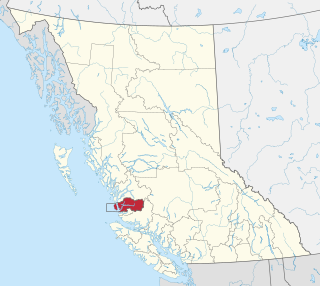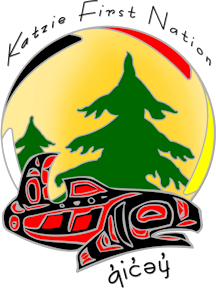Related Research Articles
Ruby Creek is a locality on the Fraser River in the District of Kent, British Columbia, Canada, in the Upper Fraser Valley region, located on BC Highway 7 and the mainline of the Canadian Pacific Railway, near the confluence of Ruby Creek with the Fraser, northeast of Sea Bird Island. Ruby Creek Indian Reserve No. 2 of the Skawahlook First Nation is nearby, as is also Skawahlook Indian Reserve No. 1, one mile northeast of the mouth of Ruby Creek. Also in the locality is Lukseetsissum Indian Reserve No. 9 of the Yale First Nation.

The Gwa'Sala-Nakwaxda'xw Nations are a union of two Kwakwaka'wakw peoples in a band government based on northern Vancouver Island in British Columbia, Canada, whose main reserve community is near the town of Port Hardy in the Queen Charlotte Strait region of the Central Coast region of British Columbia, Canada. The band government is a member of the Kwakiutl District Council and, for treaty negotiation purposes, the Winalagalis Treaty Group which includes three other members of the Kwakiutl District Council.
Ḵwiḵwa̱sut'inux̱w Ha̱xwa'mis, formerly the Kwicksutaineuk-ah-kwa-mish First Nation is a First Nations band government based on northern Vancouver Island in British Columbia, Canada, in the Queen Charlotte Strait region. It is a member of the Musgamagw Tsawataineuk Tribal Council, along with the ‘Namgis First Nation and the Tsawataineuk First Nation. The Kwikwasut'inuxw and Haxwa'mis are two of the many subgroups of the peoples known as Kwakwaka'wakw, which has two meanings: "smoke of the world" or "beach at the north side of the river."
The Lytton First Nation, a First Nations band government, has its headquarters at Lytton in the Fraser Canyon region of the Canadian province of British Columbia. While it is the largest of all Nlaka'pamux bands, unlike all other governments of the Nlaka'pamux (Thompson) people, it is not a member of any of the three Nlaka'pamux tribal councils, which are the Nicola Tribal Association, the Fraser Canyon Indian Administration and the Nlaka'pamux Nation Tribal Council.
The Tlʼesqox First Nation is a Tsilhqotʼin community located west of the Fraser Canyon in the Chilcotin region of the Canadian province of British Columbia. It is a member of the Carrier-Chilcotin Tribal Council, which includes both Tsilhqotʼin and Carrier (Dakelh) communities.

The Wuikinuxv Nation, also known as the Oweekeno Nation, is a First Nations band government whose traditional territory is the shores of Rivers Inlet and Owikeno Lake in the Central Coast region of the Canadian province of British Columbia, in the area south of Bella Bella and north of Queen Charlotte Strait. The Wuikinuxv people a.k.a. the Oweekeno people reside in the area of Rivers Inlet and Owikeno Lake, primarily at a village on the Wannock River. Substantial numbers of Wuikinuxv also reside away from the traditional territory in Port Hardy on Vancouver Island and in larger BC communities such as Campbell River, Vancouver and Victoria. Approximately 80 people reside at the village while overall membership was 283 in 2006, 194 of whom lived off-reserve.

The Lil'wat First Nation, a.k.a. the Lil'wat Nation or the Mount Currie Indian Band, is a First Nation band government located in the southern Coast Mountains region of the Interior of the Canadian province of British Columbia. It is a member of the Lillooet Tribal Council, which is the largest grouping of band governments of the St'at'imc or Stl'atl'imx people. Other St'at'imc governments include the smaller In-SHUCK-ch Nation on the lower Lillooet River to the southwest, and the independent N'quatqua First Nation at the near end of Anderson Lake from Mount Currie, which is the main reserve of the Lil'wat First Nation, and also one of the largest Indian reserves by population in Canada.
Glen Vowell is an Indian reserve community of the Gitxsan people in the Hazelton area of the Skeena Country of northwestern British Columbia, Canada. It is located on the west side of the Skeena River between Hazelton and Kispiox. Its traditional name is Sik i dak, which has also been spelled Sikadoak and is reflected in the name of the reserve, Sik-e-dakh IR 2. Also nearby is another Indian reserve, Anlaw Indian Reserve No. 4. The band government of the reserve is the Glen Vowell Indian Band, which also goes by the name Sik-e-Dakh.

The Katzie First Nation or Katzie Nation is the band government of the Katzie people of the Lower Fraser Valley region of British Columbia, Canada.
The Hartley Bay Indian Band is also known as the Gitga'at First Nation or the Hartley Bay First Nation. The members of the Gitga'at First nation are often referred to as Gitka'a'ata. The population of Gitk’a’ata peoples living in Hartley Bay ranges from approximately 130-200 people. There are also about 400-500 Gitk’a’ata peoples living in Prince Rupert, British Columbia, Canada, a neighboring territory. The Gitk’a’ata people have lived in Hartley Bay for hundreds of years, if not always. Some notable things regarding the Gitga'at First Nation are their economy, geography, government, sports involvement, COVID-19 regulations, and relations.
Yale First Nation is a First Nations government located at Yale, British Columbia. Yale has 16 distinct reserves stretching from near Sawmill Creek to American Creek, with the most southern reserve situated at Ruby Creek in the District of Kent.
The Chuckwalla River is a river in the Central Coast region of British Columbia, Canada, flowing into Kilbella Bay, which is a side water of Rivers Inlet. The river's headwaters are at 51°52′N127°54′W.
The Kilbella River is a river in the Central Coast region of British Columbia, Canada, flowing into Kilbella Bay, which is an arm of Rivers Inlet.
Katit Indian Reserve No. 1 is the main Indian reserve of the Wuikinuxv people, and is one of the three reserves governed by the Wuikinuxv Nation band government. It is located in British Columbia, Canada, on the entrance to Owikeno Lake on the north side of the Wannock River near to, but separate from, the non-native community and sport fishing resort of Rivers Inlet. Similarly named Katit Island is in the Wannock River at 51°40′41″N127°11′48″W, while Kahtit Creek is downstream, near the mouth of the Wannock River at 51°40′47″N127°15′00″W near the Wuikinuxv village known as Oweekeno.
Cockmi Indian Reserve No. 3, officially Cockmi 3, is one of the three Indian reserves of the Wuikinuxv Nation band government located on the west tip of Walbran Island, which is near Darby Channel in the area of Fitz Hugh Sound on the Central Coast of British Columbia, Canada. The other two Wuikinuxv reserves are Kiltala Indian Reserve No. 2 on the Kilbella River near Kilbella Bay and Katit Indian Reserve No. 1, up the Wannock River from the community of Rivers Inlet at the entrance to Owikeno Lake.
Takush Harbour is a harbour on the south side of Smith Sound in the Central Coast region of British Columbia, Canada. Nathlegalis IR No. 3 of the Gwa'sala-'Nakwaxda'xw Nations band government of the Kwakwaka'wakw peoples is located in Browning Channel in front of the harbour. The Takush River enters Smith Sound in the same area, at Ahclakerho Channel.

The Nekite River is a river in the Central Coast region of British Columbia, Canada, flowing south to the head of Smith Inlet. Nekite Indian Reserve No. 2 is located at the mouth of the river and is one of the many reserves of the Gwa'sala-'Nakwaxda'xw Nations band government located in the area of Smith Sound, of which Smith Inlet is the uppermost part.
Naysash Inlet is an inlet on the Central Coast of British Columbia, Canada, branching off the north side of Smith Inlet in the Smith Sound area. Naysash Bay is located just inside the entrance to Naysash Inlet at 51°18′59″N127°20′35″W. Naysash Creek, formerly Boulder Creek, flows southwest into Naysash Inlet at 51°20′21″N127°19′15″W.
Gwayasdums is a village of the Kwakwaka'wakw peoples on the west side of Gilford Island in the Johnstone Strait region of the Central Coast of British Columbia, Canada. The village, located on Retreat Pass, is on Gwayasdums Indian Reserve No. 1. Other spellings of the name are Kwaustums and gwa'yasdams and Gwa'yasdams and Gwa’yasdams.
Drury inlet is an inlet in the Queen Charlotte Strait region of the Central Coast of British Columbia, Canada, extending west from Wells Passage to the northwest of North Broughton Island, northwest of the town of Port Hardy. Branching off to the northeast from the north side of the head of the inlet is Actaeon Sound.
References
51°42′00″N127°21′00″W / 51.70000°N 127.35000°W